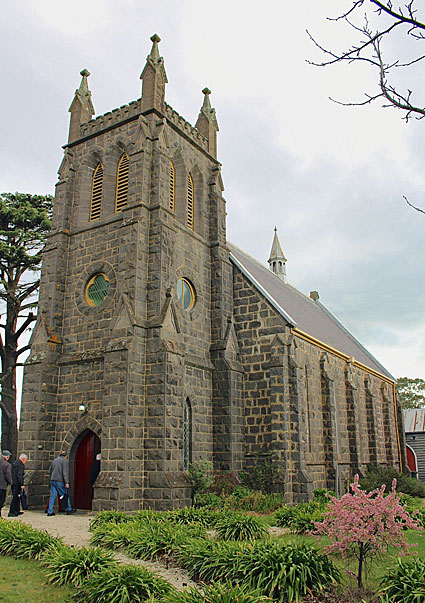
St John's Anglican Church, Creswick: exterior
[photograph by Trevor Bunning (September 2017)]

St John's Anglican Church, Creswick: exterior
[photograph by Trevor Bunning (September 2017)]
Historical and Technical Documentation by John Maidment
© OHTA, 2016, 2018 (last updated April 2018)
St John's Church was built in 1861 in bluestone to the Gothic design of the Ballarat architect H.R. Caselli. The brick chancel and bluestone tower were added later. The lofty interior includes a rear gallery and a small organ recess opening off the chancel, and fine stained glass by William Montgomery, Melbourne, van der Poorten, Brussels and E.R. Suffling, London.1
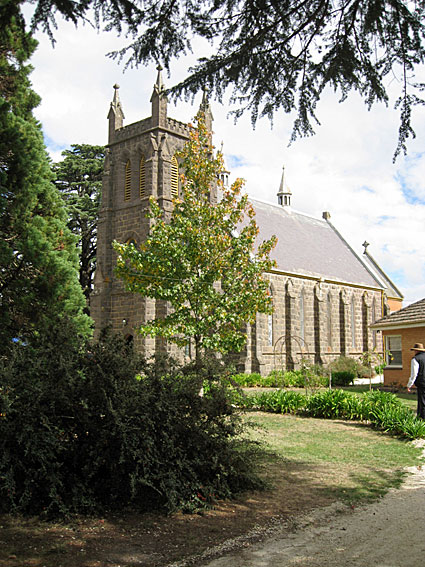
St John's Anglican Church, Creswick: exterior
[photograph by Geoffrey Cox (16 April 2016)]

The Fincham & Hobday organ before removal from the Uniting Church, Barkly Street, Ballarat
[photograph by John Maidment (2 November 2006)]
The organ was built for the Wesleyan Church, Barkly Street, Ballarat and opened on 12 April 1889. Dating from 1860, the Ballarat church was designed by the local architect J.A. Doane and constructed in red brick in the Early English Gothic style.2

The former Wesleyan Church, Barkly Street, Ballarat
[photograph by John Maidment (2 November 2006)]
The organ was constructed by Fincham & Hobday, Richmond, at a cost of £450.3 Its opening was described in a local newspaper as follows:
OPENING OF A NEW ORGAN.
The opening of the new organ for the Barkly street Wesleyan Church took place last evening, when a sacred concert and organ recital were given by the church choir, assisted by some of the best organists and vocalists of Ballarat. The opening of anew organ is an event of special musical interest. Through the long course of many centuries, from the days of Jubal, who was "the father of all such as handle the harp and organ," to the present time, the king of instruments has developed from the rude mouth organ or Pan's pipes of primitive tunes, till it has become a triumph of human skill, and enjoys the distinction of being the most perfect musical instrument that the ingenuity of man has devised. It was not till the 11th century that the organ assumed its present design and proportions, when the first instrument with a key board was erected in the Magdeburg Cathedral. Then the keys were something like 6 inches in width, and were at least a yard long, or about the size of the treadle of a knifegrinder's machine. Improvements came slowly, and it was not until a comparatively recent period that important successive improvements led up to the construction of the perfect instrument a good example of which was opened last evening at the Barkly street church. The organ is built by Messrs Fincham and Hobday, and is of imposing exterior. It contains two manuals, each with a compass of 56 notes, from C C to G. It has also an independent pedal organ with a compass of 30 notes from C C C to F, constructed on the tubular pneumatic principle. Its stops are:- On the great organ—open diapason, claribel, dulciana, the last two being very effective stops; principal, flute, and fifteenth. On the swell organ—Double diapason, open diapason, gedact, gemshorn (2), gamba, and oboe. The pedal organ contains grand open diapason and bourdon. There are three sets of couplers, swell to great organ, swell to pedal, and great to pedal, with three combination pedals. The recitals given during the evening proved the instrument to be one of which the church congregation has reason to be proud. It has a rich tone, and exhibited none of the incidental defects often met with in first performances on a new organ.4
The casework was designed by Fincham & Hobday and incorporates splayed sides, elaborate carving and a v-shaped central tower. This design was also utilized at the Congregational (now Uniting) Church, Glenelg, South Australia, St Patrick's Catholic Church, Albury, NSW and the Methodist Church, Albert Park, Vic. The façade pipes are elaborately decorated.

Façade pipes and casework
[photograph by John Maidment (2 November 2006)]

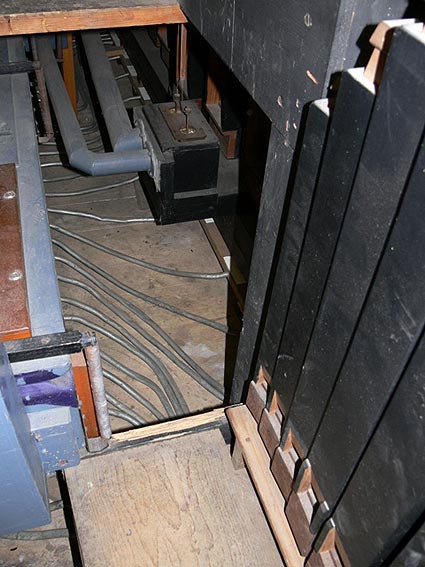
Early tubular-pneumatic pedal action
[photographs by John Maidment (2 November 2006)]
The organ includes a very early tubular-pneumatic pedal action which is original to the organ, although the manual and stop action is mechanical. Some of the stop labels have black facing, a feature also to be seen at the Uniting Church, Richmond, Vic.


Left and right drawstop jambs
[photographs by Trevor Bunning (September 2017)]
The original double-rise reservoir and feeders were replaced in the 1950s by George Fincham & Sons Pty Ltd who also placed tuning slides on the metal pipework.
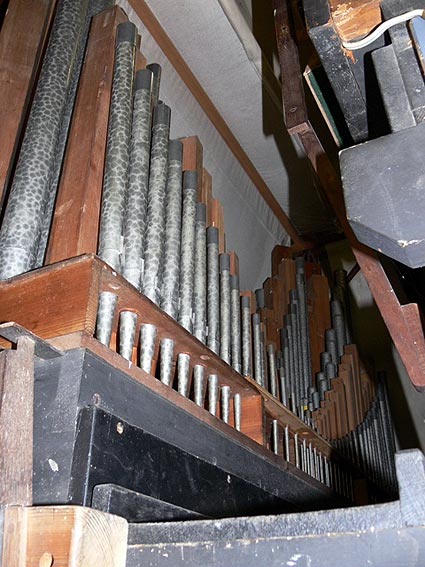
Spotted metal pipework of the Great Organ
[photograph by John Maidment (2 November 2006)]
With the sale of the Barkly Street church in 2015, the organ was given to St John's Church by the Uniting Church congregation. It was dismantled by Hargraves Pipe Organs Pty Ltd, assisted by Goldfields Pipe Organs, and moved to the Hargraves workshop at Mt Evelyn.
The rear gallery of the Creswick church was reconstructed to accommodate the organ and the central section has been moved forwards with a new central glass balustrade.

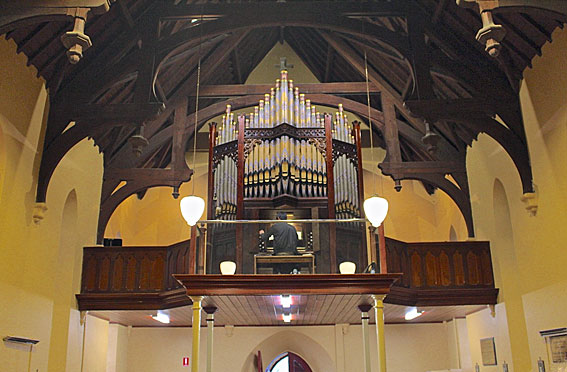
St John's Anglican Church, Creswick: organ from nave
[photographs by Trevor Bunning (September 2017)]
The work included the cleaning of the pipework and action and replacement of building frame posts that had been affected by borer. The casework was repolished on a voluntary basis by the Clunes Freemasons and the façade pipes had a coating of subsequent varnish removed.
The work has been assisted by an OHTA-sponsored appeal.
| GREAT Open Dia Clarabella [Dulciana] * Principal Clear Flute Fifteenth Swl to Gt SWELL Dou Dia Open Dia Stopd Dia [Gamba] * Gemshorn Piccolo Oboe Tremulant PEDAL Open Dia Bourdon Gt to Ped Sw to Ped |
8 8 8 4 4 2 16 8 8 8 4 2 8 16 16 |
TC by lever pedal |
* both erroneously labelled Viola 8
Compass: 56/30
Mechanical action to manuals and stops
Tubular-pneumatic action to Pedal
Attached drawstop console
Lever swell pedal
3 composition pedals to Great
2 composition pedals to Swell (never installed)5
The organ was reopened at Creswick on Saturday 16 April 2016 followed by a recital given by John O'Donnell.
1 Victorian Churches, edited by Miles Lewis. Melbourne: National Trust of Australia (Victoria), 1991, p. 114.
2 Victorian Churches, op. cit., p. 94.
3 E.N. Matthews, Colonial Organs and Organbuilders (Carlton: Melbourne University Press, 1969), p. 159.
4 The Ballarat Star (13 April 1889), p. 4.
5 Specification and notes compiled by John Maidment, April 2016.
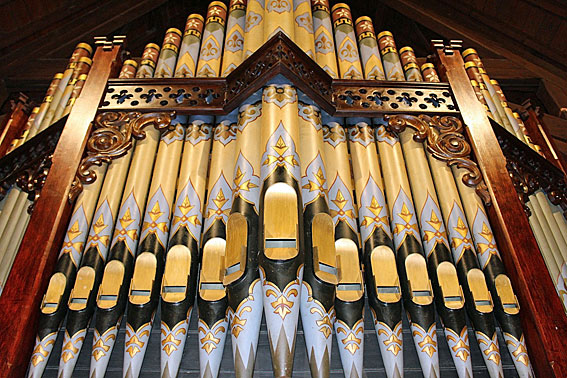
St John's Anglican Church, Creswick: façade pipes
[photograph by Trevor Bunning (September 2017)]
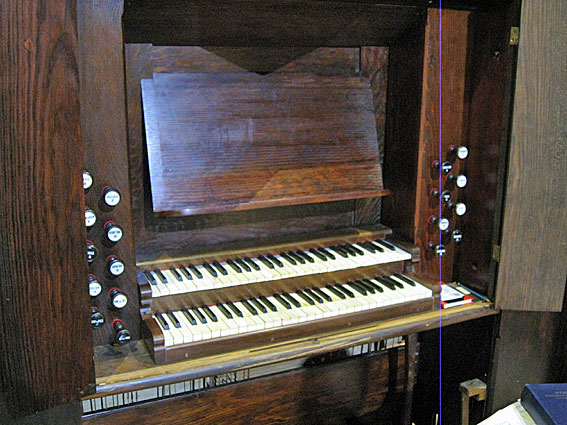
St John's Anglican Church, Creswick: console
[photograph by Geoffrey Cox (16 April 2016)]
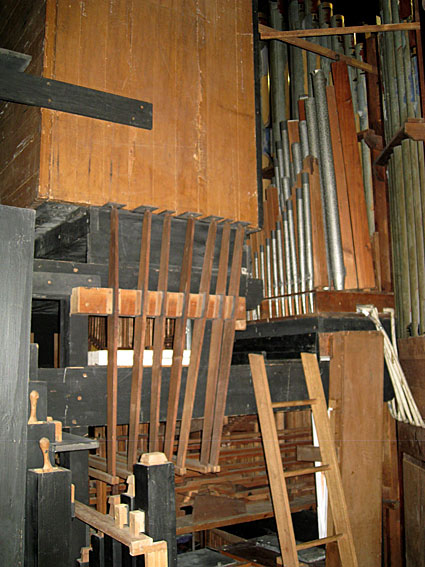
St John's Anglican Church, Creswick: organ interior C side
[photograph by Geoffrey Cox (16 April 2016)]

St John's Anglican Church, Creswick: Great windchest and pipework C# side
[photograph by Geoffrey Cox (16 April 2016)]


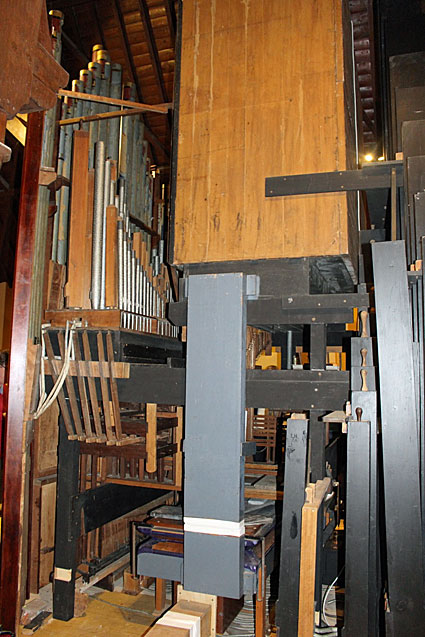
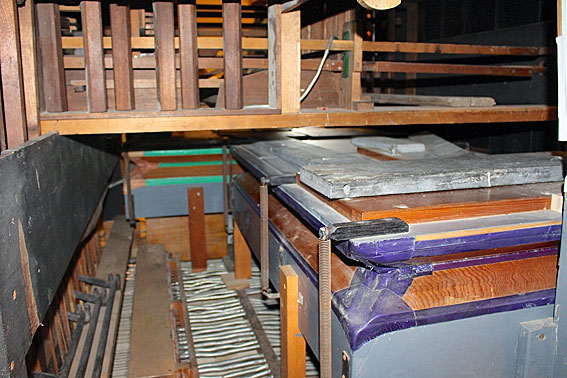
Four photographs above: St John's Anglican Church, Creswick: organ interior
[photographs by Trevor Bunning (September 2017)]
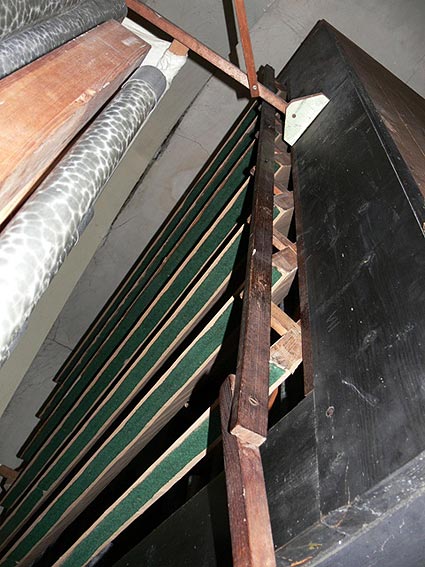
Swell box with horizontal shutters
[photograph by John Maidment (2 November 2006)]